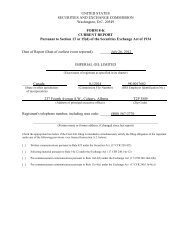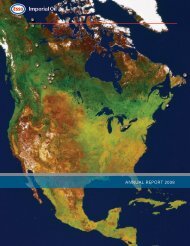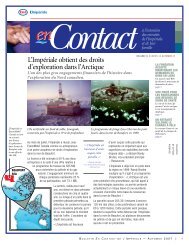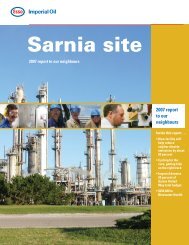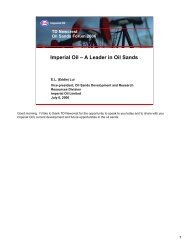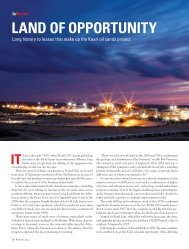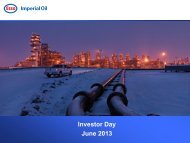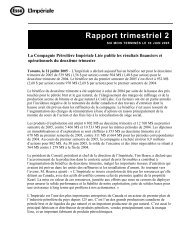FORM 10-K IMPERIAL OIL LIMITED
FORM 10-K IMPERIAL OIL LIMITED
FORM 10-K IMPERIAL OIL LIMITED
You also want an ePaper? Increase the reach of your titles
YUMPU automatically turns print PDFs into web optimized ePapers that Google loves.
etaining its 70 percent interest in the other exploration licence for about 113,000 gross hectares<br />
(279,000 gross acres). In early 2001, the Company acquired about a 17 percent interest in three additional<br />
deep water exploration licences for about 475,000 gross hectares (1,174,000 gross acres). In 2004, these<br />
licences were allowed to expire. The Company is not planning further exploration in these areas.<br />
In early 2004, the Company acquired a 25 percent interest in eight deep water exploration licences<br />
offshore Newfoundland in the Orphan Basin for about 2,125,000 gross hectares (5,251,000 gross acres).<br />
In February of 2005, the Company reduced its interest to 15% through an agreement with another<br />
company. The Company’s share of proposed exploration spending is about $<strong>10</strong>0 million with a minimum<br />
commitment of about $25 million. In 2004, the Company participated in a 3-D seismic survey in this area.<br />
In 2004, the Company converted nine exploration permits in the Laurentian basin area offshore<br />
Newfoundland and Labrador to a single exploration licence for about 192,000 gross hectares<br />
(474,000 gross acres). The Company holds a <strong>10</strong>0 percent interest in this licence.<br />
Petroleum Products<br />
Supply<br />
To supply the requirements of its own refineries and condensate requirements for blending with<br />
crude bitumen, the Company supplements its own production with substantial purchases from others.<br />
The Company purchases domestic crude oil at freely negotiated prices from a number of sources.<br />
Domestic purchases of crude oil are generally made under 30-day contracts. There are no domestic<br />
purchases of crude oil under contracts longer than 60 days.<br />
Crude oil from foreign sources is purchased by the Company at competitive prices mainly through Exxon<br />
Mobil Corporation (which has beneficial access to major market sources of crude oil throughout the world).<br />
Refining<br />
The Company owns and operates four refineries. Two of these, the Sarnia refinery and the Strathcona<br />
refinery, have lubricating oil production facilities. The Strathcona refinery processes Canadian crude oil, and<br />
the Dartmouth, Sarnia and Nanticoke refineries process a combination of Canadian and foreign crude oil. In<br />
addition to crude oil, the Company purchases finished products to supplement its refinery production.<br />
In 2004, capital expenditures of about $159 million were made at the Company’s refineries. About<br />
60 percent of those expenditures were on new facilities required to meet Government of Canada regulations<br />
on the sulphur level in motor fuels with the remaining expenditures being on safety and efficiency<br />
improvements, and environmental control projects.<br />
The approximate average daily volumes of refinery throughput during the five years ended December 31,<br />
2004, and the daily rated capacities of the refineries at December 31, 1999 and 2004, were as follows:<br />
Average Daily Volumes of<br />
Daily Rated<br />
Refinery Throughput (1)<br />
Capacities at<br />
Year Ended December 31 December 31 (2)<br />
2004 2003 2002 2001 2000 2004 1999<br />
(thousands of cubic metres)<br />
Strathcona, Alberta.................................... 27.1 27.6 26.0 25.4 27.0 29.8 28.6<br />
Sarnia, Ontario.......................................... 17.2 14.7 16.5 16.5 16.2 19.2 19.2<br />
Dartmouth, Nova Scotia.............................. 12.7 13.0 12.5 12.3 11.2 13.1 13.1<br />
Nanticoke, Ontario .................................... 17.3 16.3 16.2 17.2 17.2 17.8 17.8<br />
Total............................................... 74.3 71.6 71.2 71.4 71.6 79.9 78.7<br />
Average Daily Volumes of<br />
Daily Rated<br />
Refinery Throughput (1)<br />
Capacities at<br />
Year Ended December 31 December 31 (2)<br />
2004 2003 2002 2001 2000 2004 1999<br />
(thousands of barrels)<br />
Strathcona, Alberta.................................... 170 174 163 160 170 187 180<br />
Sarnia, Ontario.......................................... <strong>10</strong>8 92 <strong>10</strong>4 <strong>10</strong>4 <strong>10</strong>2 121 121<br />
Dartmouth, Nova Scotia.............................. 80 82 78 77 70 82 82<br />
Nanticoke, Ontario..................................... <strong>10</strong>9 <strong>10</strong>2 <strong>10</strong>2 <strong>10</strong>8 <strong>10</strong>8 112 112<br />
Total............................................... 467 450 447 449 450 502 495<br />
(1) Refinery throughput is the volume of crude oil and feedstocks that is processed in the refinery atmospheric<br />
distillation units.<br />
(2) Rated capacities are based on definite specifications as to types of crude oil and feedstocks that are processed in<br />
the refinery atmospheric distillation units, the products to be obtained and the refinery process, adjusted to include<br />
an estimated allowance for normal maintenance shutdowns. Accordingly, actual capacities may be higher or lower<br />
than rated capacities due to changes in refinery operation and the type of crude oil available for processing.<br />
Refinery throughput was 93 percent of capacity in 2004, three percent higher than the previous year.<br />
11



